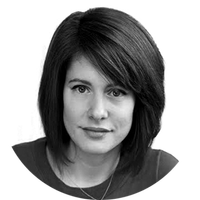The case for doing everything outside
If you want to reopen the economy, you have to think outside of the building (weather permitting, of course)


There are many things we don't know about COVID-19. But we do know being outside is safer than being inside, where we're forced physically closer together and ventilation systems are a known culprit in spreading infection.
It's not impossible to catch the coronavirus outdoors, but public health experts consider outside transmission extremely unlikely if people take appropriate precautions. "I think outdoors is so much better than indoors in almost all cases," Virginia Tech engineering professor and aerosol expert Linsey Marr told The New York Times. "There's so much dilution that happens outdoors. As long as you're staying at least 6 feet apart, I think the risk is very low."
This means two things. First, people going to the beach, pool, or park aren't being reckless if they're maintaining distance from others and practicing proper hygiene. And second, if we want to safely move toward normalcy before there's a vaccine, reliable treatments, or widespread natural immunity, we should move life outside as often as we can.
The Week
Escape your echo chamber. Get the facts behind the news, plus analysis from multiple perspectives.

Sign up for The Week's Free Newsletters
From our morning news briefing to a weekly Good News Newsletter, get the best of The Week delivered directly to your inbox.
From our morning news briefing to a weekly Good News Newsletter, get the best of The Week delivered directly to your inbox.
This isn't the wild idea it may seem. In Scotland, an outdoor learning model is being considered as an option for safely reopening schools this fall. "There are a growing number of fully and partially outdoor childcare settings in Scotland," Scottish Children's Minister Maree Todd said to The Guardian. "This model could have many benefits for maintaining physical distancing and minimizing risk of transmission as part of the transition from lockdown back into early learning and childcare and school." Scotland's "forest schools" offer unique benefits for a few students already. Even very small children learn to happily spend all day outside in the rain (a lot of rain — it's Scotland) and the sun alike.
Taking education outside obviously has its obstacles. Weather is a real consideration, particularly for older students whose coursework can't center on wandering through the woods. Computer labs can't move outdoors; bathroom logistics must be settled; and school-provided lunches probably require a cafeteria kitchen.
But is the alternative truly better? CDC guidance for opening schools and other childcare facilities proposes masking children from age 3 onward. Does that seem likely to succeed? Or how do you keep a class of 20 kindergartners from touching each other's toys, as the CDC suggests? And who is going to disinfect every desk in every room while high schoolers change classes? Do we want to give teachers another responsibility? Do we trust 14-year-olds to do it themselves? Or consider the guidance to create one-way walking paths in school halls. Have you seen middle schoolers when the bell rings?
Education isn't the only activity we could shift outdoors. Already some cities are considering closing parking lanes or entire streets to give restaurants more room for "patio" seating. Reopening at 25 or 50 percent capacity to comply with distancing regulations often won't be feasible: Many restaurants would spend more money on basic operating costs than they can earn at that scale. The only way to make reopening better than hibernation is to increase outdoor capacity, and, especially in older downtown areas, the street is the only space restaurants can use to expand.
A free daily email with the biggest news stories of the day – and the best features from TheWeek.com
Gathering outside could work for churches and other religious assemblies, too. Drive-in services don't strike me as much better than a Zoom call — maybe they're preferable for congregations with more cars and fewer tech skills, but they can't really replicate the normal feeling of community. Meeting outdoors would put churches in compliance with many reopening plans, like California's, and missing comforts like pews and childcare would encourage shorter, safer services.
The inevitable protest to this proposal, of course, is that being outside is often inconvenient. It is too hot or too cold or too wet or too windy. We live in buildings for a reason. But under pandemic conditions, indoors can become the more inconvenient place. The comparison to consider is not outside vs. inside but outside with approximate normalcy vs. inside with endless contortions in pursuit of safety.
And being outdoors will become easier the more we do it. It takes about two weeks for our bodies to acclimate to cold or hot temperatures, and acclimation is more thorough than you might expect. (My first winter in Minnesota, I was pleasantly surprised to find a sunny 35 degrees feels like t-shirt weather after weeks of sub-zero nights.)
We can get used to more than temperature, too. There's an idea in psychology called the "hedonic treadmill" which says our baseline for contentment tracks with our conditions. We can get used to living happily with less — or take for granted living with more. This is how people in other times and places could be satisfied with conditions we find unfathomable.
And doing more stuff outside isn't exactly unfathomable. It's good for us, providing benefits that are especially needful in this pandemic, like better sleep, lower anxiety, and more vitamin D. We might actually come to like it. We might accidentally learn to live outside even after this pandemic is over.
Bonnie Kristian was a deputy editor and acting editor-in-chief of TheWeek.com. She is a columnist at Christianity Today and author of Untrustworthy: The Knowledge Crisis Breaking Our Brains, Polluting Our Politics, and Corrupting Christian Community (forthcoming 2022) and A Flexible Faith: Rethinking What It Means to Follow Jesus Today (2018). Her writing has also appeared at Time Magazine, CNN, USA Today, Newsweek, the Los Angeles Times, and The American Conservative, among other outlets.
-
 The Week’s big New Year’s Day quiz 2026
The Week’s big New Year’s Day quiz 2026Quiz of the Year How much do you remember about 2025’s headlines? Put yourself to the test with our bumper quiz of the year
-
 Is tanking ruining sports?
Is tanking ruining sports?Today's Big Question The NBA and the NFL want teams to compete to win. What happens if they decide not to?
-
 ‘Netflix needs to not just swallow HBO but also emulate it’
‘Netflix needs to not just swallow HBO but also emulate it’instant opinion Opinion, comment and editorials of the day
